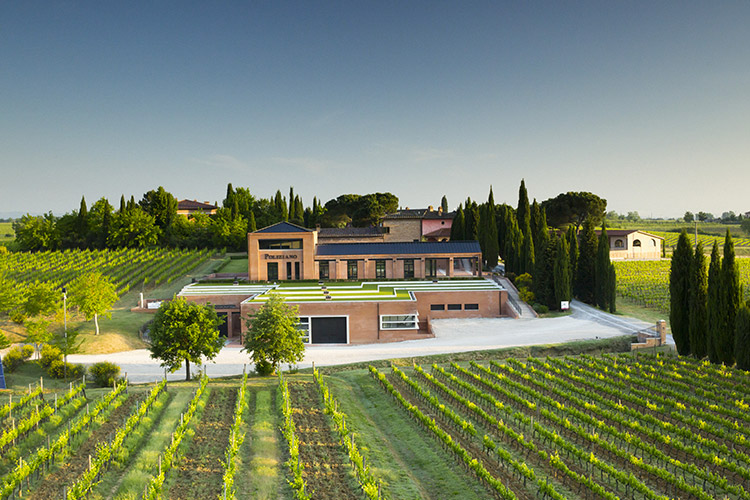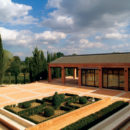Vino Nobile di Montepulciano & Poliziano
Montepulciano's history has always been linked to the fame of its wine. Legend says that the town was founded by the Etruscan King Lars Porsenna and the people of Chiusi, who changed its name from Mons Mercurius to Mons Politicus. In 1868, many bronze items produced in Chiusi were discovered in an Etruscan tomb near Montepulciano. These included a cylix (wine cup) depicting the image of Fulfluns, the Etruscan version of Bacchus (the god of wine) playing with a maenad at cottabus, a game in which wine plays a leading role. The fame of the vineyards of Mons Pulitianus has been documented since the late Middle Ages. In the 16th Century, the cellar man to Pope Paolo III Farnese defined Montepulciano as 'vino da Signori'm a wine suitable for noble tables.

Vino Nobile's industry developed in the 1920s and 1930s, and Fantini and Cantucci are two estates from that time still producing wines. In 1933, Cantina Fanetti presented a prestigious, highly-praised red wine at the first exhibition of typical local wines held in Siena. Other wineries followed this example, and in 1937 a cooperative winery was founded with the aim of creating a sales structure for wine produced by small-scale growers. Most of the wine produced was Chianti, with small quantities of Nobile. However, today the cooperative mainly produces and bottles Vino Nobile. In the sixties, there was a dramatic increase in vineyard planting, as it happened in Chianti and Montalcino. Thanks to Avignonesi and Poliziano, Vino Nobile gained momentum in the 80s. Avignonesi introduced his Vino Nobile in 1978 and also planted international varieties like Cabernet and Merlot. Recognition of a DOCG status came in 1980, and Vino Nobile began a new life.
The style of Vino Nobile remains difficult to pinpoint. Depending on the producers, you can find resiny, spicy and herbal wines, or fruity and rich ones. Generally speaking, Vino Nobiles have softer tannins than Brunello, and broader, less acidic profiles than Chianti Classicos. The slopes of Montepulciano are generally more open, allowing more sunlight than the tight, steep ones of Chianti Classico and Montalcino. The altitudes are similar, but the soils are generally sandier and more alluvial, allowing for an earlier ripening of the grapes. Vino Nobile strikes a balance between Chianti Classico and Brunello.
 The story of Poliziano started in 1961 when Dino Carletti bought 22 hectares of land in Montepulciano, and planted specialised vineyards. In 1980, Federico Carletti took charge of the estate, with a more contemporary approach and production philosophy. Over the years, the vineyards increased outside the Montepulciano denomination, in Magliano and Cortona.
The story of Poliziano started in 1961 when Dino Carletti bought 22 hectares of land in Montepulciano, and planted specialised vineyards. In 1980, Federico Carletti took charge of the estate, with a more contemporary approach and production philosophy. Over the years, the vineyards increased outside the Montepulciano denomination, in Magliano and Cortona.
The vineyards in Montepulciano are mostly in the south, sloping towards the east, and are grown at an altitude of 280-450m above sea level. The soil here is mainly clay and volcanic tufo, with a moderate presence of stones. The vineyards in the Cortona DOC denomination produce the lable In Violas, and are divided into two parcels: Farrata, at an altitude of 350m with sand and clay-rich soil with some skeletal stones, and Cignano, where vines are planted on clay soil with southwest exposure, and at an altitude of 300m. The Losha label is produced in Maremma, where the vineyards near Magliano are planted on rich, sandy, clay and limestone soils.
The vineyards are cultivated organically and each plot is taken care of by hand, from choosing the buds, to pruning or tying back the trellis. They do not use fertilisers or pesticides, instead implementing a rigorous agronomic management, a terroir driven by biodiversity and sustainability.

With more than 50 years of experience, Poliziano has perfected the handling process in the cellar, with the objective of producing wines that are not uniform but are expressive of their territory, with nuances and personality. In the cellar, the grapes are sorted with a new state-of-the-art fibre optic camera destemming machine, the first of its kind in Italy. Poliziano is the perfect combination of new technological approach, and traditional values and wisdom.
The fermentation cellar was build in 1988, positioned directly beneath the area where the grapes are destemmed, therefore using gravity to move the must into the tanks instead of pumps. The stainless-steel tanks allow for controlled temperature and micro-oxygenation, and the techniques used are punching down, delestage, and pumping-over with the different varieties fermented separately. The main aim of the maceration is to extract the pest polyphenols from the skins, the most noble of the tannins. The wines mature in a dedicated aging cellar, completed in 2005, with around 4000 barrels between barriques and tonneaux, including an automated system of controlling the humidity and washing and cleaning the barrels.

I was hosted by Jennifer, a lovely American lady who is also a writer and knows her wine very well. We tasted the Rosso di Montepulciano 2015, the Vino Nobile di Montepulciano 2014, the Vino Nobile di Montepulciano Asinone 2013, and the Mandrone di Lohsa 2012. The Rosso is a blend of 80% Sangiovese and 20% Merlot and part of the wine spends around six months in big bottle. It's a wine produced to be fresh and young, with intense fruits such as raspberries, red cherries and hints of pepper. A great combination with an everyday meal like pizza.
Next, we had the Vino Nobile 2014, a wine made with 80% Sangiovese plus Colorino and Canaiolo, aging in wood for 15 months, two thirds in French barrique and tonneaux and a third in traditional bottle. Medium intensity on the nose, with notes of red and black fruit, cherries, forest fruit, and some aromatics; soft, smooth tannins with a crisp character. Though it was a different vintage, the wine was very elegant and balanced.
Then it was time for the top one, the Asinone 2014. The grapes for this wine come from a 12-ha vineyard, where years of experimentation with Sangiovese identified the best potential for this variety. The wine spends around 18 months in French barrique and tonneaux. It's intense, perfumed; wild berries, spices and cedar on the nose; the tannins are tight and it does feel as if it would benefit from some more years in bottle; lots of red and black fruit on the palate, such as dark cherries and ripe plums, but it is perfectly balanced by a vibrant acidity; very long length. The more you drink, the more you think it's a 'meditation wine'. After a few minutes, Jennifer said I had to try it with 8-month aged pecorino Pienza DOP, claiming it was the best match with Asinone- and she was right!

Last but not least, we tasted the Mandrone di Losha, a Maremma Toscana DOC blend of 80% Cabernet Sauvignon, 10% Petit Verdot, and 10% Alicante. The wine spends 18 months in new French barriques and 6 months in bottle. It's peppery, with tobacco notes, sweet spices and blackcurrant. Even though it's a big wine, it's surprisingly easy to drink, with hints of smoke and dark plums, and a refreshing acidity. A wine I would definitely drink with a barbeque.
A big thank you to Poliziano's hospitality- the place is unbelievable, and the wine even better.
